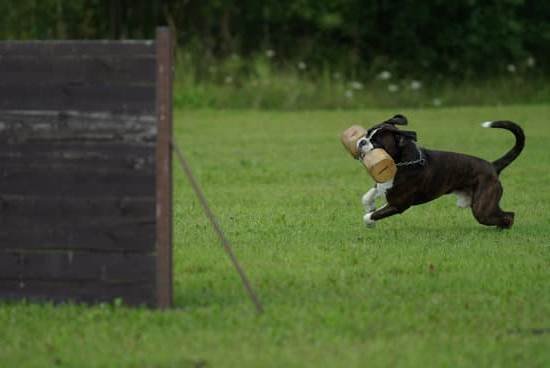Training your dog to ring a bell is not only an impressive trick, but it also serves as a valuable communication tool between you and your furry friend. By teaching your dog to ring a bell, you are providing them with a means to let you know their needs or wants, such as going outside for a bathroom break or wanting to play.
In this article, we will guide you through the process of training your dog to ring a bell step by step, ensuring that both you and your pet have the best possible experience. From choosing the right bell that suits your dog’s preferences and abilities to troubleshooting common challenges, we’ve got you covered.
Teaching your dog this skill comes with numerous benefits. Not only does it enable effective communication, but it also promotes problem-solving skills and mental stimulation in your canine companion. Moreover, it can help prevent accidents indoors by giving your dog an alternative way to request bathroom breaks rather than scratching at doors or barking excessively.
So whether you’re looking for a fun new trick to teach your pup or hoping to establish clear communication channels, this article will provide you with all the information and guidance needed to train your dog to ring a bell effectively. Get ready to embark on an exciting journey of training and bonding with your four-legged friend.
Benefits of Teaching Your Dog to Ring a Bell
Teaching your dog to ring a bell can have numerous benefits for both you and your furry friend. Here are some of the key advantages of incorporating bell training into your dog’s routine:
- Communication: By teaching your dog to ring a bell, you are providing them with a clear and effective way to communicate their needs. Instead of resorting to barking, scratching or other disruptive behaviors, your dog can simply ring the bell when they need to go outside, want attention, or require something else.
- House Training: Bell training is particularly useful for house training your dog. When they learn to associate ringing the bell with signaling their need to go outside, accidents in the house can be significantly reduced. This saves you from constantly guessing when your dog needs to relieve themselves and helps establish a routine for them.
- Mental Stimulation: The act of learning and performing a new behavior like ringing a bell provides mental stimulation for dogs, which is essential for their overall well-being. This type of training engages their problem-solving skills and can help alleviate boredom, preventing the development of destructive behaviors.
To maximize the benefits of teaching your dog to ring a bell, it’s important to choose the right type of bell that suits both your dog’s preferences and training goals. Next section will guide you on how to pick the perfect bell for your furry companion.
References
- https://www.akc.org/dog-breeds/
- https://pets.webmd.com/
- https://en.wikipedia.org/wiki/Dog_training
Choose the Right Bell
When it comes to training your dog to ring a bell, choosing the right bell is crucial. The bell you select should be suitable for your dog’s size, temperament, and preferences. Here is a handy guide to help you pick the perfect bell for your furry friend.
- Consider Size: Dogs come in various sizes, so it’s essential to choose a bell that is appropriate for your dog’s size. A small dog may struggle with a large or heavy bell, while a larger dog may need a more substantial bell that can withstand their strength. Additionally, make sure the bell is easy for your dog to reach and manipulate with their paws or nose.
- Material: Bells come in different materials, including metal, plastic, or even fabric. Consider your dog’s preferences and chewing habits when selecting the material. Metal bells are durable but may make more noise compared to plastic ones. Fabric bells can be gentle on sensitive noses but might not be as long-lasting as other options.
- Sound: The sound of the bell is an important factor to consider. Different bells produce varying levels of noise and tones. Some dogs may respond better to a higher-pitched sound, while others prefer lower tones. Experiment with different bells and observe how your dog reacts to find the sound that motivates them.
Once you have chosen the right type of bell for your dog, securely attach it near the door or area where you want them to signal when they need to go outside or perform any desired behavior. Remember that every dog is unique, so don’t get discouraged if it takes some trial and error to find the perfect fit. Your patience and effort in choosing the right bell will pay off in successful training sessions with your furry companion.
| Criteria | Description |
|---|---|
| Size | Choose a bell appropriate for your dog’s size and easy for them to manipulate. |
| Material | Select a material based on your dog’s preferences and chewing habits. |
| Sound | Consider the noise level and tone that motivates your dog. |
Step-by-Step Guide
Training your dog to ring a bell can be a useful skill for various reasons. Whether you want to teach your furry friend how to communicate their need to go outside or simply want to engage them in an interactive game, bell training can bring both practicality and fun into your daily routine. Follow this step-by-step guide to successfully train your dog to ring the bell.
Step 1: Introduce the Bell
Start by introducing your dog to the bell you have chosen for training. Allow them to sniff and investigate it without any pressure. You can try incorporating positive reinforcement such as treats or praise during this initial stage so that your dog associates the bell with something positive.
Step 2: Encourage Touching
Next, encourage your dog to touch or interact with the bell intentionally. You can do this by holding a treat near the bell and rewarding them when their nose, paw, or mouth touches it. Repeat this process multiple times until your dog consistently touches the bell on command.
Step 3: Create Association
Establish a connection between ringing the bell and going outside or any other desired action. For example, every time you take your dog out, make sure they touch the bell before opening the door. Gradually reinforce this association until they start associating ringing the bell with their desired outcome.
Step 4: Add Verbal Command
Introduce a verbal cue or command that you will use along with ringing the bell. This could be something like “ring” or “outside.” Use it consistently whenever you ask your dog to touch the bell. Over time, they will learn to associate that specific command with ringing the bell.
Step 5: Practice and Reinforce
Consistency is key when training dogs, so practice regularly with short sessions throughout the day. Slowly increase the difficulty by adding distractions or asking your dog to ring the bell from a distance. Always reward them with treats, praise, or access to their desired outcome whenever they successfully ring the bell.
Remember that each dog is unique, and training progress may vary. Some dogs may pick up on this skill quickly, while others may take longer. Be patient with your furry friend and celebrate even small victories along the way. With dedication and positive reinforcement, your dog will soon become proficient at ringing the bell and communicating their needs effectively.
Common Mistakes to Avoid While Teaching Your Dog to Ring a Bell
Common Mistakes to Avoid While Teaching Your Dog to Ring a Bell
When it comes to training your dog to ring a bell, there are some common mistakes that many dog owners make. Avoiding these mistakes can help ensure a smoother and more successful training process for both you and your furry friend.
One common mistake is rushing through the training process. It’s important to remember that every dog learns at their own pace, so patience is key. Don’t expect your dog to understand the concept of ringing a bell immediately. Instead, break down the training into small steps and gradually increase the difficulty as your dog progresses.
Another mistake to avoid is not being consistent with training sessions. Consistency plays a crucial role in teaching your dog any new skill, including bell ringing. Set aside specific times each day for training sessions and stick to them. This will help reinforce the behavior and make it more likely for your dog to understand what is expected of them.
Additionally, using punishment or negative reinforcement during bell training is another mistake that should be avoided. Yelling at or scolding your dog when they don’t ring the bell will only confuse and scare them. Instead, focus on positive reinforcement techniques such as praise, treats, or rewards whenever your dog successfully rings the bell.
By avoiding these common mistakes, you can set yourself and your dog up for success in bell training. Remember to be patient, consistent, and use positive reinforcement techniques throughout the training process.
Troubleshooting
In the process of training your dog to ring a bell, you may encounter some common challenges. This section will provide solutions and strategies to help you overcome these obstacles and ensure successful bell training for your furry friend.
One common challenge in bell training is that your dog may become confused or hesitant about ringing the bell. If your dog is not understanding the concept or seems unsure, try using positive reinforcement techniques. Whenever your dog makes any attempt at ringing the bell, reward them with treats, praise, or playtime. By reinforcing their efforts, you are encouraging them to continue and understand the desired behavior.
Another challenge may arise if your dog is not interested in the bell itself. Some dogs may be more motivated by different types of bells or sounds. Experiment with different bells – such as jingle bells, sleigh bells, or even a doorbell sound effect on your phone – to discover which one captures their attention and enthusiasm the most.
Additionally, if you find that your dog is consistently refusing to ring the bell even after understanding what it means, it could be due to fear or anxiety. Gradual desensitization can help in this situation. Start by introducing the bell from a distance and rewarding any positive interactions. Slowly decrease the distance between your dog and the bell over time until they feel comfortable enough to touch and ring it.
| Challenge | Solution |
|---|---|
| Dog confusion/hesitation | Use positive reinforcement techniques to reward any attempts at ringing the bell |
| Lack of interest in the bell | Experiment with different types of bells or sounds until you find one that motivates your dog |
| Fear or anxiety towards the bell | Gradually desensitize your dog to the bell by introducing it from a distance and rewarding positive interactions |
Advanced Tips and Tricks
Introducing Distractions
Once your dog has mastered the basic concept of ringing the bell to go outside, you can begin to introduce distractions to further challenge their bell training skills. Start by gradually adding distractions one at a time, such as having another person play with a toy or making noises in the background while your dog is attempting to ring the bell. This will teach your dog to focus on ringing the bell regardless of any external stimuli.
Another effective way to advance your dog’s bell training is by incorporating different locations. Start by introducing the bell in various rooms of your home and gradually progress to outdoor settings such as your backyard or a nearby park. This will help your dog generalize the behavior and understand that ringing the bell means they can go outside no matter where they are.
Integrating Verbal Commands
To enhance your dog’s understanding of when and why they should ring the bell, you can introduce verbal commands into their training routine. Start by associating a specific command, such as “ring” or “bell”, with the action of touching their nose to the bell. Use this command consistently every time you want them to ring the bell and reinforce their behavior with treats and praise.
With practice, your dog will start recognizing the verbal command and its connection to ringing the bell. This can be particularly useful when you’re unable to physically see them near the door but still want them to alert you that they need to go outside. Just remember to keep reinforcing this command throughout their training sessions.
Adding Complexity: Multiple Bells
If you want to take your dog’s bell training even further, consider adding multiple bells at different heights in various locations around your home. This will require your dog to differentiate between bells and target specific ones when requesting access outside. Use distinct cues or commands for each different location with varying numbers of rings.
By incorporating multiple bells, you’ll be challenging your dog’s cognitive abilities and problem-solving skills. It also provides them with a more comprehensive understanding of the bell training concept, as they will need to discriminate between different bells based on location and specific cues.
Overall, advanced tips and tricks in bell training can enhance your dog’s skills and deepen their understanding of the training process. Remember to be patient and consistent during these advanced stages, gradually increasing difficulty while reinforcing positive behavior with praise and rewards. With dedication and practice, your dog will become a proficient bell ringer in no time.
Utilizing Bell Training in Everyday Situations
Once you have successfully trained your dog to ring the bell, there are numerous practical applications for this skill in everyday situations. Bell training can greatly improve communication and make various aspects of daily life easier and more efficient for both you and your dog.
One practical application of bell training is potty training. By teaching your dog to ring the bell whenever they need to go outside, you no longer have to rely on them scratching at the door or barking to let you know when they need to use the bathroom.
Instead, they can simply ring the bell, alerting you that it’s time for a bathroom break. This method not only helps prevent accidents inside the house, but also gives your dog a clear way to communicate their needs.
Another useful application of bell training is teaching your dog to notify you when they need something. For example, if your dog wants to go for a walk or play with their favorite toy, they can ring the bell to get your attention. This eliminates any confusion or frustration on both ends, as your dog now has a reliable way of expressing their desires, and you can easily understand what they want.
Additionally, bell training can be utilized during mealtimes. By teaching your dog to ring the bell before mealtime or when their food bowl is empty, they can communicate when they are hungry and ready for food. This not only allows you to establish a consistent feeding schedule for your dog but also prevents them from resorting to undesirable behaviors such as begging or stealing food.
Incorporating bell training into these everyday situations empowers your dog with a means of communication beyond basic commands like sit or stay. It strengthens the bond between you and your furry companion by fostering understanding and mutual cooperation in various scenarios throughout the day.
- Potty training: Teach your dog to ring the bell when they need to go outside
- Notifying needs: Use the bell to indicate desires such as going for a walk or playing with a toy
- Mealtime communication: Train your dog to ring the bell before mealtime or when their food bowl is empty
By implementing bell training in these everyday situations, you create a harmonious and efficient environment for both you and your dog. It allows your furry friend to express their needs and desires while giving you clarity on what they require. With practice and consistency, your dog will become adept at utilizing the bell in various practical applications, ultimately enhancing your daily routines together.
Reinforcing Bell Training
Once you have successfully trained your dog to ring a bell, it is important to reinforce their training regularly to ensure that they maintain and strengthen their skills. Reinforcing bell training not only helps your dog remember what they have learned, but it also allows them to continue developing their skills and build a stronger bond with you. Here are some tips on how to maintain and strengthen your dog’s bell training.
Firstly, it is crucial to establish consistency in the use of the bell. Make sure that every time your dog needs to go outside, you guide them towards the bell and encourage them to ring it before opening the door. By consistently using the bell as part of their routine, your dog will associate ringing the bell with going outside. This reinforcement will help them remember what the bell signifies and continue using it in the future.
Regular practice sessions should also be incorporated into your dog’s training schedule. Set aside dedicated time each day or week specifically for practicing their bell skills. During these sessions, repeat the steps of the training process by guiding them towards the bell and rewarding them when they ring it.
Over time, gradually increase the difficulty by introducing distractions or increasing distance between your dog and the bell. These practice sessions will help keep your dog sharp and maintain their proficiency in ringing the bell.
Additionally, continue providing positive reinforcement for your dog’s efforts. Positive reinforcement can include praise, treats, or playtime whenever they successfully ring the bell on their own or even make an attempt to do so. This positive reinforcement serves as motivation for your dog to continue using the bell and strengthens their association between ringing it and receiving rewards.
Remember that patience is key when reinforcing bell training. Your dog may have occasional slip-ups or lapses in behavior, but remain consistent in reinforcing good behavior while gently redirecting any mistakes. By staying patient, understanding, and consistent throughout this process, you can help maintain and strengthen your dog’s skills in ringing a bell.
Conclusion
In conclusion, training your dog to ring a bell is not only a useful skill but also a fun and rewarding experience for both you and your furry friend. By teaching your dog to communicate their needs through the bell, you are providing them with an effective way to ask for things like going outside or getting treats. This not only improves their quality of life but also strengthens the bond between you and your pet.
Throughout this article, we have explored the benefits of teaching your dog to ring a bell, such as promoting communication and mental stimulation. We have provided a step-by-step guide on how to train your dog to ring the bell, as well as common mistakes to avoid and solutions to challenges that may arise during the training process. Additionally, we have offered advanced tips and tricks for those who want to take their bell training skills further.
By incorporating bell training into everyday situations, you can enhance your dog’s ability to communicate effectively with you. Whether it’s alerting you they need to go potty or indicating they want to play, bell training can be utilized in various practical applications in your daily routine. It is an excellent tool for creating harmony in your home while also meeting your dog’s needs promptly and efficiently.
Finally, remember that reinforcement is vital in maintaining and strengthening your dog’s skills in bell training. Consistency and positive reinforcement are key elements in ensuring long-term success. Celebrate each small victory along the way and continue challenging your dog by introducing new commands or scenarios. With time, patience, and dedication, you will witness the incredible potential that bell training has unlocked within your furry companion.
Frequently Asked Questions
How do I teach my dog to ring a service bell?
Teaching a dog to ring a service bell can be done through consistent training and positive reinforcement. Start by introducing the dog to the bell and allowing them to investigate it. Next, associate the bell with going outside by placing it near the door.
Each time you take your dog out, use a verbal command like “bell” and gently guide their paw or nose to touch the bell before opening the door. As they make contact with the bell, immediately praise and reward them with treats or verbal praise. Practice this routine consistently over time so that your dog associates ringing the bell with going outside.
Should I teach my dog to ring a bell to go outside?
Teaching a dog to ring a bell to go outside can be a useful communication tool between you and your pet. It provides them with an alternative way of letting you know when they need to go out rather than barking or scratching at doors.
By teaching your dog this skill, you empower them to communicate their needs effectively. Additionally, ringing a bell can also serve as mental stimulation for your pup, as they learn how to use their paws or noses in different ways.
What is the bell method for dogs?
The bell method for dogs is a training technique that involves using a bells system near the door as a signal for dogs to communicate their need to go outside. This method typically consists of hanging bells on a string or strap at nose height near the exit point of your home. The goal is to train your dog to associate ringing those bells with wanting to go outside for bathroom breaks or walks.
By consistently reinforcing this behavior each time your dog rings the bells, they will learn that it leads to positive outcomes such as being let out or going for walks. This method works best when combined with positive reinforcement techniques such as treats and praise whenever the desired behavior occurs.

Welcome to the blog! I am a professional dog trainer and have been working with dogs for many years. In this blog, I will be discussing various topics related to dog training, including tips, tricks, and advice. I hope you find this information helpful and informative. Thanks for reading!





